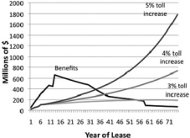Article from: www.thenewspaper.com/news/39/3929.asp
10/22/2012
Report Labels Indiana Toll Road an Intergenerational Cash Transfer
Financial analysis of Indiana Toll Road lease finds its true costs shifted heavily to future generations.
 A College of William and Mary professor believes the toll road public-private partnerships currently in vogue among transportation bureaucrats may end up costing the public a great deal of money in the long run. John B. Gilmour makes the case in the journal Public Administration Review, using the Indiana Toll Road as an example.
A College of William and Mary professor believes the toll road public-private partnerships currently in vogue among transportation bureaucrats may end up costing the public a great deal of money in the long run. John B. Gilmour makes the case in the journal Public Administration Review, using the Indiana Toll Road as an example.
In 2006, the road was leased for 75 years to Macquarie-Cintra, a consortium of Australian and Spanish tolling companies, in return for an up-front payment of $3.8 billion to the state government. At the time, Governor Mitch Daniels (R) hailed the project as innovative. Far from being innovative, Gilmour argues the practice is medieval.
"In the Middle Ages, the children of people who died in debt were responsible for their parents obligations and could be held in a debtors' prison to ensure repayment," Gilmour wrote. "Today, happily, laws shield children from intergenerational debt collection. No laws stop governments, however, from borrowing and shifting the cost of repayment to future generations. This can be a very attractive strategy for politicians who wish to provide costly benefits to contemporary voters without imposing any costs on them."
The lease arrangement is the equivalent of a loan or revenue bond repaid by giving up the right to collect future toll revenue. Gilmour set out to determine the distribution of costs and benefits over the entire 75-year term for the deal.
Governor Daniels set aside the majority of the money raised by the lease to his "Major Moves" ten-year transportation initiative. Another $500 million was placed in the Next Generation Trust which allowed investment profits to be spent once every five years. By Gilmour's calculation, the useful life of all the projects funded would be exhausted by the sixtieth year of the lease. Only the trust fund would provide benefits beyond that date.
On the other hand, there is no end to the toll increases motorists will have to pay. Each year, the rate will jump two percent, the rate of GDP growth or the inflation rate -- whichever of the three is greatest. Gilmour calculated the cost of the deal in 25-year increments with three separate assumptions regarding the increase in toll rates and three different discount rates.
"Even with a modest annual 3 percent toll increase, it is clear that the ITR lease represents a large intergenerational transfer," Gilmour wrote. "With larger toll increases, the imbalance over time is far worse."
With a zero percent discount rate, the first 25 years will pay between 4 and 13 percent of the costs of the road while those living in the final 25 years of the lease bear between 56 and 78 percent of the costs.
"To the extent that asset leases serve as a means of shifting the cost of current consumption to future generations, they rest on dubious ethical ground," Gilmour wrote. "Viewed from the perspective of fairness to future generations, the ITR lease is insupportable... It is easy to see why current politicians view asset leases with up-front payments as wonderful, allowing them to spend today without raising taxes or appearing to incur debt. In short, the ITR lease is a great deal for current residents of Indiana, but it offers little to those who will live in Indiana in future decades."
Gilmour recommended a change in accounting practices be implemented that would show current revenue from up-front payments offset by a debit representing loss of future revenue.
"Adoption of accrual accounting would help individuals understand that the up-front payment is not new revenue, just revenue shifted in time," Gilmour wrote.
Source: The Indiana Toll Road Lease as an Intergenerational Cash Transfer (Public Administration Review, 8/23/2012)
Permanent Link for this item
Return to Front Page
 A College of William and Mary professor believes the toll road public-private partnerships currently in vogue among transportation bureaucrats may end up costing the public a great deal of money in the long run. John B. Gilmour makes the case in the journal Public Administration Review, using the Indiana Toll Road as an example.
A College of William and Mary professor believes the toll road public-private partnerships currently in vogue among transportation bureaucrats may end up costing the public a great deal of money in the long run. John B. Gilmour makes the case in the journal Public Administration Review, using the Indiana Toll Road as an example.